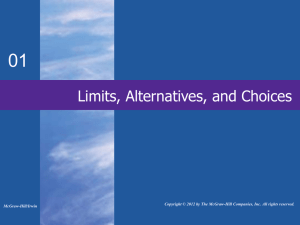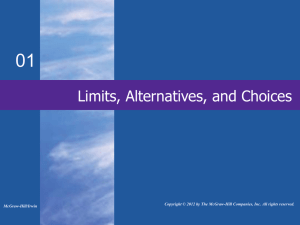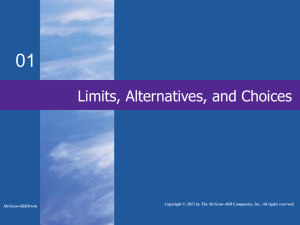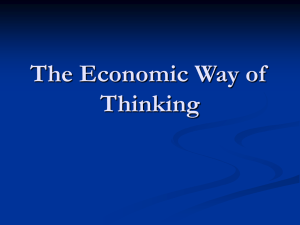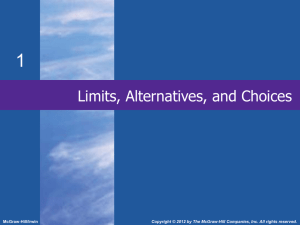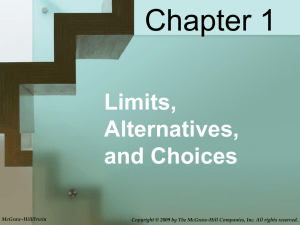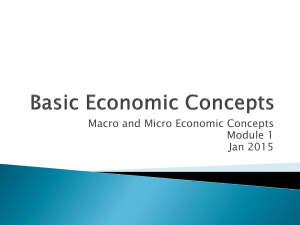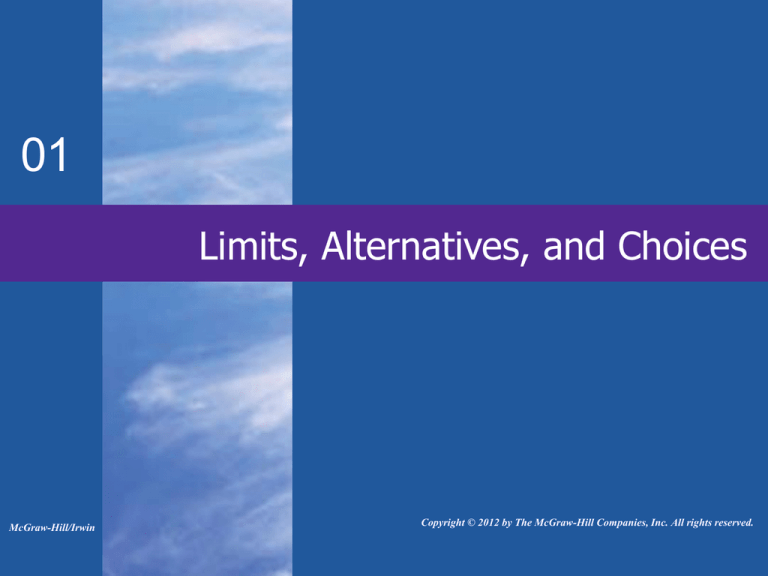
01
Limits, Alternatives, and Choices
McGraw-Hill/Irwin
Copyright © 2012 by The McGraw-Hill Companies, Inc. All rights reserved.
Introduction
• Economic wants exceed
productive capacity
•
LO1
Economics: A social science
concerned with making optimal
choices under conditions of
scarcity
1-2
The Economic Perspective
LO1
Scarcity and
Choice
Purposeful
Behavior
Marginal
Analysis
• Resources
are scarce
• Choices must
be made
• Opportunity
cost
• There’s no
free lunch
• Rational
self-interest
• Individuals
and utility
• Firms and
profit
• Desired
outcomes
• Marginal
benefit
• Marginal cost
• Marginal
means extra
• MB and MC
1-3
Opportunity Cost
• The goods and services that could have been
produced but are sacrificed is called
opportunity cost.
• That “free lunch” is at the expense of other
crops, other farm laborers, etc.
– To get more of one thing, you forgo the
opportunity of getting something else.
Marginalism
• Marginal analysis: comparisons of marginal
benefits and marginal costs
• Marginal means “extra” or “additional”
• Every option involves marginal benefits and
marginal costs (because of scarce resources)
– Should you attend school for another year or not?
– Should the government increase its funding for a
missile defense system?
– Should a business expand or reduce its output?
Microeconomics and Macroeconomics
•
•
Microeconomics: Decision making by
individual units
Macroeconomics: Examines either the
economy as a whole or its basic
subdivisions or aggregates (collection of
specific economic units being treated as
one unit
• The government
• Household sectors
• Business sectors
• Millions of consumers get lumped together
and just called “consumers”
LO3
1-6
Macro vs. Micro
Positive and Normative Economics
•
Positive economics: Deals with
economic facts and causeand-effect relationships
• Theoretical economics
•
Normative economics: A
subjective perspective of the
economy
• Value judgments about what the economy should be
like or what policies should be enacted to achieve a
desirable goal
LO3
1-8
Examples
• Positive economics
statement: “The
unemployment rate in
several European
nations is higher than
that in the US”
• Normative economics
statement: “European
nations ought to
undertake policies to
reduce their
unemployment rates”
Pitfalls to Sound Economic Reasoning
•
Biases
•
•
•
“What is true for one individual is true for the whole”
Post hoc fallacy
•
•
Tabloid journalism
Fallacy of composition
•
•
Some people think that more government regulation is better than
less regulation
Loaded terminology
•
•
Some people think corporate profits are excessive
“A comes before B so A must have caused B”
Correlation not causation
1-10
Individual’s Economizing Problem
• Limited income
• Unlimited wants
• A budget line
• Attainable and unattainable options
• Trade-offs and opportunity costs
• Make the best choice possible
• Change in income
LO4
1-11
Individual’s Economizing Problem
12
DVDs
$20
Books
$10
6
5
4
3
2
1
0
0
2
4
6
8
10
12
10
Quantity of DVDs
$120 Budget
Income = $120
Pdvd = $20
8
=6
Unattainable
6
Income = $120
Pb = $10
4
2
0
Attainable
2
4
6
8
10
12
Quantity of Paperback Books
LO4
= 12
14
1-12
Society’s Economizing Problem
• Scarce resources
• Land
• Labor
• Capital
• Entrepreneurial Ability (takes
initiatives, makes decisions,
innovates, and takes risks)
LO4
1-13
Production Possibilities Model
• Illustrates production choices
• Assumptions
• Full employment
• Fixed resources
• Fixed technology
• Two goods
LO5
1-14
Production Possibilities Model
Production Alternatives
Type of Product
Pizzas
A
B
C
D
E
0
1
2
3
4
10
9
7
4
0
(in hundred thousands)
Industrial Robots
(in thousands)
Plot the Points to Create the Graph…
LO5
1-15
Industrial Robots
Production Possibilities Model
14
13
12
11
10
9
8
7
6
5
4
3
2
1
A
B
Unattainable
C
U
D
The law of
increasing
opportunity
costs makes
the PPC
concave.
Attainable
E
0 1 2 3 4 5 6 7 8 9
Pizzas
LO5
1-16
Industrial Robots
A Growing Economy
14
13
12
11
10
9
8
7
6
5
4
3
2
1
A’
B’
Unattainable
A
B
C’
C
Economic
Growth
D’
D
Now Attainable
Attainable
E’
E
0 1 2 3 4 5 6 7 8 9
Pizzas
LO6
1-17
Present Choices, Future Possibilities
LO6
Future
Curve
Current
Curve
P
Goods for the Future
Goods for the Future
Compare Two Hypothetical Economies
Future
Curve
F
Current
Curve
Goods for the Present
Goods for the Present
Presentville
Futureville
1-18

